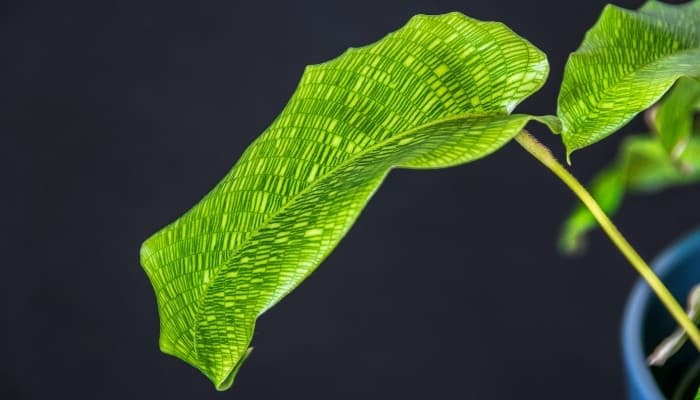The Calathea musaica is known by several alternate names in the plant industry, such as the bella Calathea and the network Calathea, attributed to its intricate foliage design.
When well cared for, this plant’s glossy, bright leaves reward owners with a stunning yellow and green labyrinth pattern.
How do you care for Calathea musaica? Calathea musaica requires perpetually moist pH-neutral soil that drains well, bright but indirect sunlight, temperatures of 65-80°F, high humidity levels, and a nitrogen-rich fertilizer once per month during the growing season. Consistent moisture and ideal lighting are imperative.
Caring for Calathea Musaica: Basic Guidelines
As less sensitive compared to others in the Calathea family, Calathea musaica makes a great houseplant for confident beginners.
This guide will cover not only how to mimic their ideal environment but how to sustain it, plus answers to many common queries.
Complete Care Guide for Calathea Musaica
Native to Brazil, Calathea musaica was first discovered in 1875 by English Botanist William Bull, and its name derives from its intricate mosaic-like leaf veination.
These are less widely available compared to other Calathea varieties, making it a highly coveted plant among collectors.
Common names for this beauty include the network plant, Calathea ‘Network’, network prayer plant, and Calathea bella.
Calathea Musaica at a Glance
- Plant Type: Evergreen
- Scientific Name: Goeppertia kegeljanii ‘Network‘
- Average Height: 2 feet
- Average Width: 3 feet
- Growth Rate: Medium
- Produces Flowers: Yes
- Common Pests: Thrips, red spider mites
- Life Expectancy: Years with proper care
- Difficulty of Care: Easy
What To Do When You First Get Your Calathea Musaica
- Check the leaves and stems closely for any signs of pests (symptoms detailed further on). Early detection can prevent lasting damage to the foliage and may protect neighboring plants from infestation.
- Place your finger in the top 2 inches of soil. You should only water your new plant immediately if these top inches feel dry to the touch. If the soil still feels moist, check back until it feels dry to avoid overwatering.
- Choose an ideal location for it, and keep the plant in the plastic nursery pot it arrived in. It needs time to adjust to its surroundings and won’t respond well to being moved unless necessary.
Ideal Soil for Calathea Musaica
Calathea musaica needs a pH-neutral soil mix that drains well while retaining moisture to supply enough nutrients without overwhelming the roots.
Plant collector and curator of the Plantophiles blog Marcel Iseli recommends: “two-thirds peat moss and one-third crushed orchid bark to improve drainage.”
Calathea Musaica Water Requirements
Distilled or filtered tap water is best and should be room temperature to avoid shocking the plant.
While unfiltered tap water won’t do immediate harm, long-term use will start to cause browning on the leaf tips due to the fluoride levels present.
Watering may be needed every 1 or 2 weeks – remember to do the touch test to see if the soil is thirsty (bone dry) or satiated (moist).
Calathea Musaica Lighting Needs
Calathea musaica needs bright but indirect sunlight to mimic its naturally sheltered rain forest conditions.
As a rule of thumb, it should not be placed directly in front of a window, though due to its higher tolerance for light compared to other calatheas, direct early morning and evening light can be beneficial in the winter months.
Ideal Temperature Range for Calathea Musaica
Temperatures in the 65-80°F (18-30°C) range will see your plant thrive, and it will tolerate 60°F (15°C).
However, if temperatures drop below this, damage to the foliage, such as curling and browning, will occur, and before long the plant will become dormant and stop growing altogether.
Ensure it steers clear of air conditioners and drafty spots in the home.
Ideal Humidity Level for Calathea Musaica
Keep humidity levels at 50% and above, but be wary that fungal diseases can be more prevalent in a high humidity environment.
To achieve the right balance, owners, such as horticulturist and author of Houseplants Made Easy Andrew Courtney, swear by hygrometers (humidity monitors) like this dual humidity/temperature monitor.
These allow you to adjust your misting or air circulation measures as needed.
Best Location for Calathea Musaica
Corners of your kitchen or near your bathroom are usually good spots for your Calathea musaica as they can enjoy a good balance of shade and humidity there.
Low-light bedrooms may also be suitable, provided you can meet the humidity and temperature requirements.
Calathea Musaica Growth Habits
This plant grows horizontally with the leaves arching slightly to create a compact shrub-like form.
This is due to their system of roots known as a rhizome structure, which expands horizontally over time – making repotting essential every few years.
Fertilization Type & Schedule for Calathea Musaica
Use a nitrogen-rich houseplant fertilizer on moist soil once monthly between April and October, and dilute the solution strength by half.
Your plant won’t require fertilizer in the colder months as it stops growing during this period.
Signs of Nutrient Deficiency
Calathea musaica will exhibit excessively yellow leaves and brown spots and may appear wilted and droopy with an insufficient nutrient intake.
This can be down to harsh light exposure, under or overwatering, imbalanced humidity levels, or a soil mix with poor moisture retention.
Pruning Calathea Musaica
This plant only requires minimal pruning to remove dead or badly damaged foliage.
Pruning should be done using clean, disinfected pruning shears, taking care to trim stems near the soil line.
Does Calathea Musaica Produce Flowers?
This plant does flower, but don’t expect to spot any growing on your indoor Calathea musaica.
They rarely bloom indoors, and even in their natural tropical habitat, they produce only small white flowers on short stalks that tend to go unnoticed among the foliage.
Is Calathea Musaica Toxic?
The ASPCA (The American Society for the Prevention of Cruelty to Animals) lists Calathea musaica as a nontoxic houseplant along with all Calathea varieties.
Calathea Musaica Propagation
If you ever want to create multiple offspring plants from your original Calathea musaica or simply need to save and separate healthy roots from damaged ones, you’ll need to propagate your plant using the root division method outlined below:
1. Partially Fill Your New Plant Pots Ready for Planting
Newly separated root segments stand a better chance of survival if they’re in moist soil as quickly as possible.
Prepare each of your new pots (with drainage holes) by filling them a third of the way with soil mix.
Once the new roots are in, you can promptly add the remaining soil and water.
2. Gently Remove the Plant From Its Container To Expose the Roots
Take the bare plant base from its pot, and place it in a bag or flat work surface to begin propagating.
Carefully dismantle the soil structure with your hands until the root system is exposed.
3. Carefully Separate Root Ball Segments From the Main Root
Identify the root ball sections (where the main root splits off into separate roots) and carefully divide these from the main root.
The root should be tender enough to break off by hand, but if not, cut them close to the root crown using a sharp knife.
4. Have Patience If Growth Is Paused After Division
It’s perfectly normal for plants to cease growing in the weeks or even months following the trauma of being divided and replanted, so don’t be discouraged if your usual fertilizer and water regimen doesn’t get results for a while.
A stressed plant needs time to adjust to its environment in the same way a new sprouting would.
Repotting Calathea Musaica
As your Calathea musaica develops, you’ll need to rehome it in a larger pot and fresh soil now and again to encourage healthy growth.
When To Repot Calathea Musaica
Repotting should be done every 2-3 years, at which point the plant can become rootbound, which is when roots begin to take over in the soil and continue expanding, risking nutrient deficiency.
Repotting may also be necessary if it is evident that your current soil mix is not draining well or retaining enough moisture and needs to be changed.
Signs That It’s Time To Repot
- Roots are poking out beneath the drainage holes
- The current soil mix is draining slowly
- Roots are visible throughout the soil (becoming rootbound)
How To Repot Calathea Musaica
1. Prepare a Pot One or Two Sizes Up From the Current One
Ensuring it has drainage holes, pick a pot no larger than 2 inches up from your existing one to avoid overwatering. Wash it well before use, and fill it a third of the way with your new soil mix.
2. Remove the Plant and Examine the Roots for Signs of Spoilage
Carefully slide the bare plant base out of its container pot and gently shake off the old soil.
Once the roots are exposed, check their color and feel – healthy roots should be pale and firm to touch.
If you spot any brown, black, or mushy roots, prune those as needed.
3. Place the Plant in the New Pot – Add the Remaining Soil
Center your Calathea musaica in the new pot, and fill with the remaining two-thirds of soil mix to stabilize it, making sure the plant sits at roughly the same height as before.
Press lightly on the soil to further secure it, but try not to flatten the top layer too much as this may obstruct drainage.
4. Water Your Repotted Plant Lightly – Let It Drain Well
Water your plant slightly less than normal to avoid overwhelming the roots in their new home, and allow the excess water to drain well through the base drainage holes.
Set the pot down gently in a suitable location, and expect an adjustment period similar to post propagation.
Calathea Musaica Common Problems & Solutions That Work
Calathea Musaica Common Pests
From time to time, your Calathea musaica may attract juice-sucking, leaf-nibbling menaces.
Fortunately horticulturist Andrew Courtney has the tips on avoiding and tackling the following pests:
Thrips (Thunder Flies)
- Signs of Trouble – Mottling, streaky (not solid) yellow or browning leaves.
- Solution – Spray neem oil (find it here) on affected foliage and top soil layer. Prune badly affected leaves/stems.
- Prevention – Place sticky traps (blue traps like these are ideal for thrips) near your plant.
Red Spider Mites
- Signs of Trouble – Sticky webbing, mottled brown specks on foliage.
- Solution – Wash off webbing with a tepid weekly shower.
- Prevention – Mist often and consider introducing the predatory mite (Phytosieulus persimilis) to reduce their numbers.
Fungus Gnats
- Signs of Trouble – Yellowing, wilting leaves.
- Solution – Spray foliage with an organic pesticide like Spinosad. Introduce nematodes (predatory microscopic worms that eat gnats in the larvae stage).
- Prevention – Don’t overwater as they thrive in soggy soil. Add a dry top layer of soil to deter adult, hovering gnats.
Calathea Musaica Common Diseases
This plant is quite hardy and fairly resistant to most diseases as long as they are not overwatered or kept in too high humidity, as this is a haven for the following fungal and bacterial conditions:
Root Rot
- Signs of Trouble – Browning or yellowing foliage, discolored, mushy roots.
- Solution – Prune affected roots and foliage. Propagation of healthy roots may be necessary.
- Prevention – Review ventilation and humidity levels. Consider using a moisture monitor.
Sooty Mold
- Signs of Trouble – Greenish-black spots on foliage (developed from sticky waste product of common pests)
- Solution – Wipe affected foliage with a damp cloth and rinse leaves clean in a tepid shower.
- Prevention – Check foliage after eliminating pests to see if residue remains, and wash it off. Review ventilation and humidity conditions.
White Mold
- Signs of Trouble – White, cotton, wool-like substance coating the top soil layer.
- Solution – Rake up the affected area with a piece of cardstock, taking care not to inhale as allergy-aggravating fungal spores may have been released into the air.
- Prevention – Keep your plant adequately ventilated during colder months. Use orchid or coconut bark in your soil mix to improve air circulation.
Other Common Problems
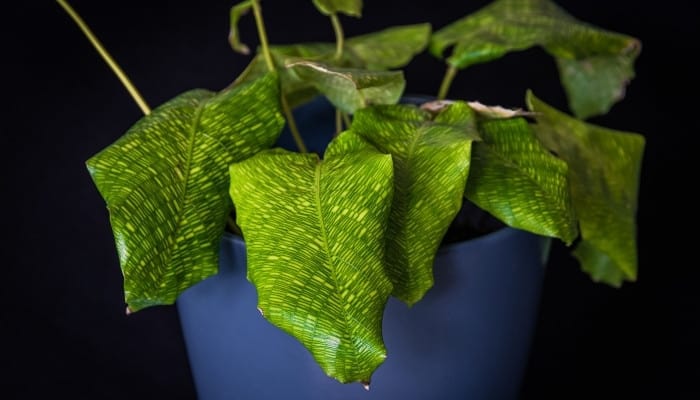
Oftentimes your Calathea musaica will simply let you know that conditions are far from ideal by displaying visible changes to the shape and color of its leaves:
Brown Leaves
- Signs of Trouble – Brown leaf tips due to saturated soil or chemical buildup from unfiltered tap water.
- Solution – Trim dead tips, following the natural shaping of the leaf. Prune excessively brown foliage.
- Prevention – Water only when the top soil layer feels dry, and use distilled/filtered tap water.
Wilting Leaves
- Signs of Trouble – Loss of vigor, limp or curling leaves.
- Solution – If bone-dry, flush the soil in lukewarm water. Otherwise, hold off from watering, and use a pebble tray to increase humidity.
- Prevention – Monitor humidity levels closely, review watering frequency.
Yellow Leaves
- Signs of Trouble – Solid yellow leaf coloring (not in patches or streaks).
- Solution – Prune affected foliage. Aerate soil using a chopstick/dowel.
- Prevention – Avoid overwatering, review location (too drafty/hot/bright), ensure soil mix is pH neutral and aerated to prevent nutrient deficiency.
Calathea Musaica Common Questions
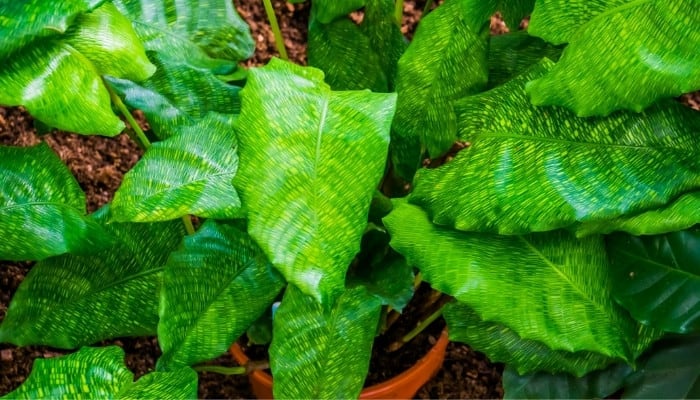
Is Calathea Musaica a Prayer Plant?
Calathea musaica are not technically prayer plants, but they are associated with true prayer plants (Marantas) due to their similar appearance.
Calathea and Maranta plants belong to the Marantaceae family but each have their own genus.
“Prayer plants” are named so because their leaves fold together at night – a mechanism known as nyctinasty, a feature that Calathea plants do not have.
What Is a Network Plant?
“Network” plants are those with dense leaf veining that resembles a city of overlapping roads.
Ecologist Benjamin Blonder explains that network plants like Calathea musaica have dense veination “because their lowland position under rainforest canopies requires them to soak up more nutrients.”
Is Calathea Musaica Patented?
A new variety of Calathea musaica known as Calathea ‘PP005’ was patented in 2008 by inventor Adrianus Dekker and features more distinctive variegation in its foliage pattern.
This variety is exclusively available in North America, and those in ownership of one may be unable to propagate this patented plant.
Is Calathea Musaica Hard To Grow?
Growing this plant is relatively easy due to its unhurried growth rate, infrequent repotting needs, and higher tolerance than other calatheas to sunlight exposure and becoming rootbound.
With ideal environmental conditions and pest control measures in place, they can thrive.
How Fast Does Calathea Musaica Grow?
Calathea musaica are quite slow-growing plants, taking up to 5 years to reach their mature size of 2 feet high and 3 feet wide, according to the Candide Gardening app and plant-lovers community.
Why Is My Calathea Musaica Turning Yellow?
Foliage can turn yellow due to overly moist soil, lack of water, pest infestations, temperature extremes, or stress from being rehomed.
Yellowing can appear streaky, in solid patches, or appear only on the tips – refer to the Common Problems section above to see which type this is consistent with and review your care accordingly.
How Often Should You Mist a Calathea Musaica?
If you don’t have a humidifier to replicate their lush rain forest conditions, you should try to mist the leaves of your Calathea musaica every other day with a specialized plant mister to prevent over-watering.
Why Are My Calathea Musaica Leaves Curling Up?
Low humidity and under or overwatering will cause leaves to dry out and curl.
Control humidity levels by investing in a humidifier and hygrometer or else mist the foliage every other day.
Check the top soil layer regularly to help you determine a watering schedule.
What Do You Do If You Overwatered a Calathea Musaica?
Check the soil’s drainage and examine the roots for signs of rot. If there is mild damage, consider replacing the soil with a fresh mix and flush it with a systemic fungicide.
Wait a few days before resuming watering. If soggy soil persists or if there is extensive root damage, propagating healthy root sections may be necessary.
How Do I Know If My Plant Roots Are Rotting?
Rotting roots will appear black and be mushy to the touch whereas healthy roots should feel firm and appear pale.
On the surface, wide-spread yellowing or brown tips on the leaves can also indicate rotting roots.
Why Is My Calathea Musaica Leggy?
Plants can become leggy in an attempt to stretch toward the sunlight in low-light conditions or when they are overfed fertilizer, causing the foliage to grow tall before the stems and roots have developed the strength to support them.
Urban Agriculturist Bonnie L. Grant recommends “early season pruning to enhance thicker, sturdier growth” in houseplants.
Why Does My Calathea Musaica Have Brown Spots?
Brown spots on your Calathea musaica can indicate a nutrient deficiency, while small mottled-brown specks may be the work of red spider mites.
Observe your plant for signs of an infestation, use the recommended soil medium, and review humidity/watering conditions.
3 Key Tips for Success With Calathea Musaica
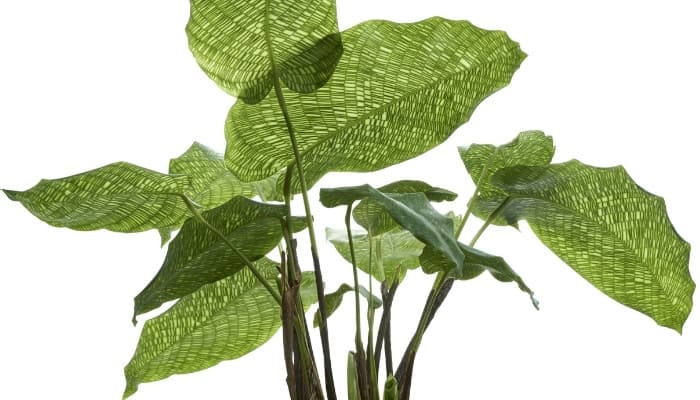
1. Go Easy on Fertilizer Use & Prioritize Ideal Conditions
While a Calathea musaica can benefit from a monthly feed from April-October, this maximum course of fertilizer isn’t essential as long as environmental conditions already have them thriving.
Feeding 2-3 times throughout spring/summer can suffice and may prevent them from becoming too leggy.
2. Treat Soil to an Occasional Cleanse To Flush Out Toxins
Since it’s impractical to change your potting soil at the first sign of poor growth, flush existing soil with lukewarm distilled water every now and then to remove salt deposits from fertilizer use and tap water chemicals.
Sustainable plant company Age Old Organics recommends “every 6-8 months.”
3. Invest in a Humidifier & Use a Hygrometer To Track Humidity
It’s often tricky to strike the right balance with misting and other humidity measures, so a humidifier can help to correct things.
Using a hygrometer to monitor humidity levels in real-time can also be super helpful in keeping disease at bay.
Conclusion
In summary, the Calathea musaica is relatively easy to care for, provided it has the right balance of light, moderate humidity, and moisture indoors to imitate its Brazilian rain forest habitat.
Maintaining an ideal environment and staying vigilant when it comes to pests and diseases will ensure owners enjoy its beautiful, distinctive foliage years after purchase.
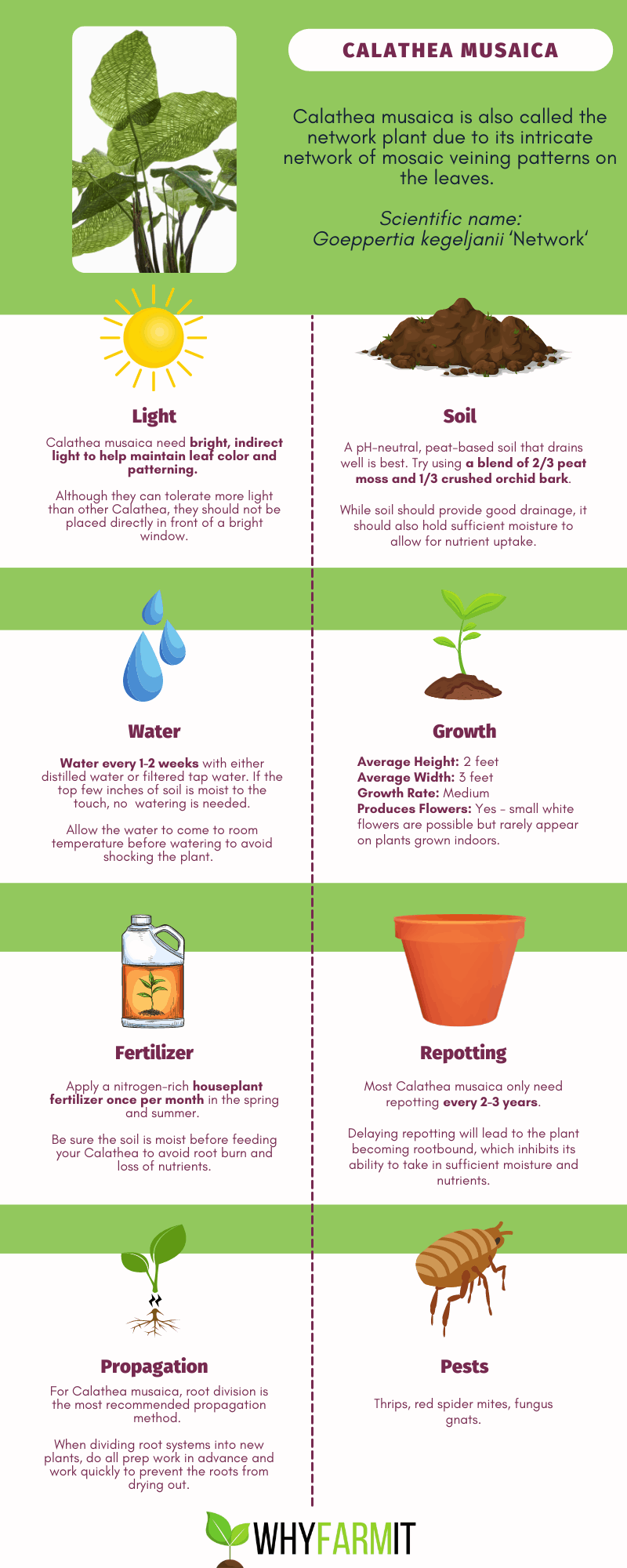
Sources:
https://www.researchgate.net/publication/282526988_p_Nomenclatural_notes_on_Goeppertia_Marantaceae_p
https://leafyplace.com/calathea-musaica/
https://plantophiles.com/plant-care/calathea-musaica-care-top-tips/
https://smartgardenguide.com/calathea-musaica-care/
https://www.youtube.com/watch?v=WdSPjI6IzUE
https://www.gardeningknowhow.com/houseplants/calathea-plants/calathea-vs-maranta.htm
https://www.youtube.com/watch?v=AYRUTDkvVBc
https://benjaminblonder.org/2014/04/17/new-paper-predicting-climate-from-leaf-venation-networks/
https://www.gardeningknowhow.com/plant-problems/environmental/established-plants-leggy.htm
https://candidegardening.com/GB/plants/e45eff25-7e4b-470b-8bc7-d35ce7eef772
https://www.brightview.com/resources/article/how-rescue-overwatered-plants
https://osera.org/houseplant-tips/do-calathea-musaica-like-to-be-misted/
https://www.ageold.com/remember-to-flush-removing-excessive-salt-build-up/

